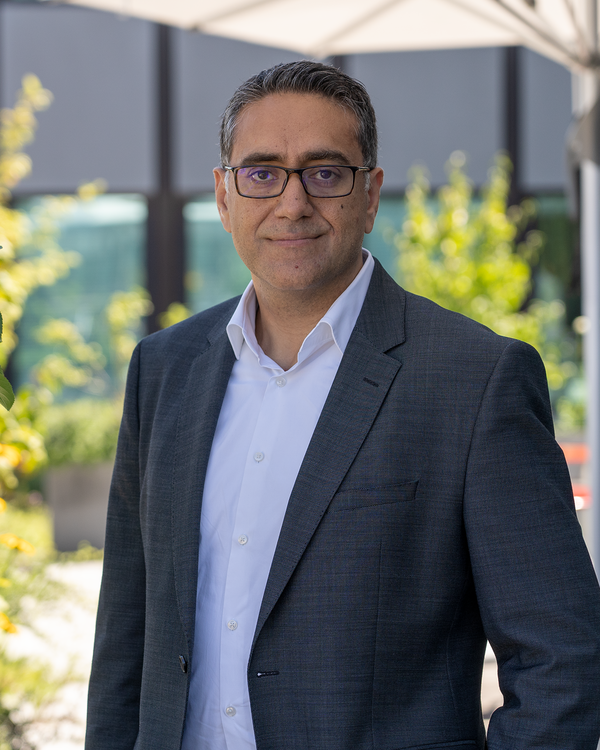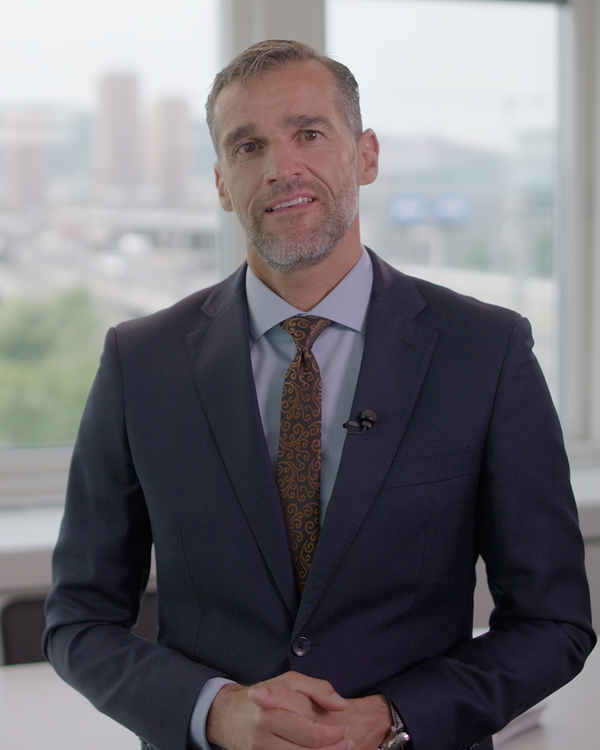"Sustainability must be an integral part of asset management"
It takes the efforts of business, politicians and consumers to effectively reduce greenhouse gas emissions and promote sustainable investments, explains Iwan Deplazes, Head of Asset Management at Zürcher Kantonalbank.
Interview with Iwan Deplazes

Sustainability and asset management – do they even fit together?
Iwan Deplazes: Yes! I even go a step further and say both topics cannot be separated from each other.
Please explain what you mean.
Sustainability involves many aspects. The now common abbreviation ESG – E for Environment, S for Social and G for Governance – is only part of this. Take retirement provision, for example. This needs to be sustainable in two ways. On the one hand, investors need good returns in order to have a secure income in old age. On the other hand, sustainability must be an integral part of asset management.
What approaches does Zürcher Kantonalbank take to guarantee sustainability?
Zürcher Kantonalbank's Asset Management takes ESG integration into account in every investment decision and analyses how companies and countries perform in terms of sustainability criteria. In this way, we weigh up whether and, to what extent, we get involved. The allocation of funds is a strong signal in itself. We always keep the entire portfolio in mind. In concrete terms, this means we do not categorically rule out as investments those companies with comparatively high CO2 emissions that also show good progress in reducing these emissions.
"A sustainable investment strategy cannot stand on exclusions alone."
So you don't see a problem if a cement manufacturer is included in a sustainable investment product?
Excluding companies based on their industry or products is one of the weakest instruments in sustainable investments. This eliminates the possibility to exert a positive influence on the behaviour of the company. For that reason: yes, we invest in Holcim because the company has ambitious goals to produce in a more environmentally friendly way – and has met them to date.
Are there companies that you exclude on principle?
Yes. We base our exclusions on the blacklist of the Swiss Association for Responsible Investments. It contains around 25 companies that violate Swiss laws and international conventions, such as manufacturers of prohibited weapons including cluster bombs. However, a sustainable investment strategy cannot stand on exclusions alone. For us, it is important to have active dialogue with the companies in which we invest in order to achieve improvements in terms of sustainability.
How do you do this?
We promote a sustainable direction by encouraging improvements and demanding them when we exercise our voting rights. Specifically, we follow the United Nations' sustainability principles. In technical jargon, this is called investment stewardship. This sustainable strategy may not seem as strong as exclusion. But it can do much more. And we are not alone here. The asset management industry is increasingly combining its power of capital allocation in line with climate targets, for example in the Net Zero Asset Managers Initiative, of which Zürcher Kantonalbank's Asset Management is a member.
What other approaches to sustainable investment are there?
We also offer thematic investments, such as funds in the areas of decarbonisation, climate and water. The thematic "Water" fund, for example, invests in companies that make an important contribution to solving the problem of water shortages and securing our water supply.
Zürcher Kantonalbank distinguishes between Sustainable funds – with a narrower selection of securities – and Responsible funds, whose selection is somewhat broader. Why this differentiation? Are not all sustainable investments equally sustainable?
Both product lines invest sustainably. The active investment funds reduce CO2 emissions in line with the 2-degree target of the Paris Agreement and systematically apply sustainability approaches such as ESG integration, investment stewardship and exclusions. The Sustainable products go one step further and take into account the positive environmental and social benefits of companies in accordance with the 17 Sustainable Development Goals defined by the UN. However, the question is: do we only want to promote companies and countries that are already sustainable?
Why not stop there?
In that case, there would be no transition for companies whose products are not yet environmentally friendly today, but who have set themselves climate targets and are demonstrably pursuing them. This transition needs to be financed. Just like at Holcim or at a car manufacturer like BMW, for example, which does not rely exclusively on electric vehicles like Tesla, but operates more energy-efficiently than Tesla.
"Our reduction target of 4 percent is already very ambitious."
How do you check that companies do not stand still on their way to becoming environmentally friendly?
Our climate strategy envisages that we reduce CO2 emissions in each actively managed fund by at least 4 percent annually. To this end, we maintain active dialogue with companies to formulate and implement effective CO2 reduction targets. We allocate the capital provided to us by the investor base specifically to such companies.
The Paris Agreement anchors the goal of limiting global warming to a maximum of 1.5 to 2 degrees. Why don't you explicitly pursue the more ambitious goal of 1.5 degrees?
We absolutely do this for selected funds in our Sustainable products! These funds invest in such a way that the annual CO2 emissions of the portfolio even fall by 7.5 percent per year. However, such a rapid CO2 reduction is almost impossible for many industries and technologies to achieve. We are realistic about what the real economy can deliver and we want to be credible. Our reduction target of 4 percent is already very ambitious. In this way, with our actively managed funds, investors invest in portfolios that follow at least the 4-percent reduction path.
How do you check the figures that the companies provide regarding their CO2 emissions?
This is no longer a problem; standardised data is now available. From 2024, companies will also have to determine the CO2 emissions from their products and services that have arisen in the upstream and downstream supply chains. These are known as Scope 3 emissions. The quality of Scope 3 data is currently poor. We put a lot of effort into improving data quality in order to provide investors with transparency.
"Zürcher Kantonalbank and many other major financial institutions devote enormous resources to the topic of sustainability."
The Federal Government recently launched the national label "Swiss Climate Scores" for sustainable financial investments. What does this mean for you?
We welcome the introduction of the Swiss Climate Scores, which provide for climate neutrality and dialogue with companies. They contribute to transparency and comparability. This helps investors to find their way around the many sustainable financial products and make better investment decisions. In our asset management, the key performance indicators are already integrated into the investment process. We check the implementation of the corresponding reporting in accordance with the Swiss Climate Scores as soon as all key performance indicators from the six sub-areas have been defined.
Paper doesn't blush, as the saying goes. How is it ensured that this does not remain a lip service?
Zürcher Kantonalbank and many other major financial institutions devote enormous resources to the topic of sustainability. We have our own team of specialists and are constantly expanding this team to deepen our know-how.
Do you not see any greenwashing?
Greenwashing may occur in the industry, for example at financial institutions that use external ratings and indices or simply rely on the use of exclusions. But this is the exception. However, the criticism is so great today that we almost have to talk about "green bashing".
«Der Zusammenhang von Nachhaltigkeit und Rendite ist in der Regel positiv.»
What advice do you give to a retail investor who would like to invest in sustainable investments with confidence?
A good approach is to define investment topics that are personally important to you. A consultation can be useful here. As with conventional investments, it is also important to include the components of risk appetite and return expectations in investment decisions. Retail investors can, for example, simply use strategic funds to invest according to their sustainability preferences.
In the past, sustainable investment meant sacrificing returns. Is that still true?
No, the opposite is true. The relationship between sustainability and return is generally positive. This has now been proven by various studies.
How confident are you that the global community – including the global financial industry – will become sustainable in practice?
The transformation is underway. The financial industry and asset management are driving ESG issues forward at full speed. It's going in the right direction. But we cannot do everything on our own. It will require efforts from all of us. It requires the real economy, the companies that reduce CO2 emissions, the politicians who set binding standards, as well as every individual who invests and consumes sustainably. To be sustainable, everyone has to pull together. We are on the right track. However, I am not so sure whether we will reduce CO2 emissions globally quickly enough to still achieve the 2-degree target.
This interview (in German only) was first published in the "Vermögensverwaltung" supplement of the Neue Zürcher Zeitung on 9 September 2022.


